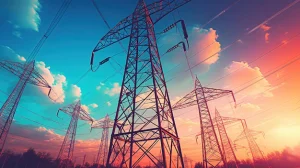D.P. Bhattacharya
Shillong, a charming hill station nestled in India, captivates visitors with its idyllic landscapes, meticulously maintained winding roads, temperate climate, and the enchanting embrace of pine forests. This haven beckons weary urban dwellers, yearning for solace and rejuvenation of both body and soul. Despite these natural blessings, the growth of this enchanting destination was impeded by a glaring deficiency: inadequate illumination.
In the early days of the British Raj, Shillong suffered from a glaring lack of proper lighting, rendering it one of the most poorly lit areas. The meager provision comprised a mere 15 petrol lamps and 75 oil lamps scattered throughout Shillong and its Cantonment vicinity, their feeble glow dimming into insignificance on moonlit nights.
This is the remarkable narrative recounting the transformation of the once dimly lit hill station, evolving from the worst-lit to the best-lit destination of its time. This transformation was wrought by the unyielding determination of a dedicated cadre of individuals. It is also the chronicle of the ascent of a native enterprise, forged amidst trials, setbacks, and uncertainty—a tale of the birth of a triumphant Indian company.
In the year 1905, when Assam merged with Eastern Bengal, the prospect of illuminating Shillong with hydroelectric power generated from its abundant water sources was entertained. Originally, the vision was to illuminate the Government House using Ward’s Lake water, but this concept was eventually discarded, as was the notion of harnessing the Crinoline Falls. This insight is gleaned from a report dated December 26, 1906, authored by Messrs. Scott-Mackenzie and Harrison. These
gentlemen, in their report, subsequently suggested the utilization of Bishop’s Falls, yet it offered scant practical insights.

The first comprehensive project report, bearing the title “Report on the Electric Lighting of Shillong,” was meticulously crafted and submitted by Mr. J.W. Meares, M. Inst. C.E., M.I.E.E., Electrical Adviser to the Government of India, in November 1908. In this groundbreaking report, Mr. Meares proposed the establishment of North Eastern India’s inaugural hydroelectric power station, which would rank as the country’s third oldest hydroelectric station. This ambitious venture sought to leverage Beaden Falls and its adjacent rapids.
In his report, Mr. Meares asserted that Shillong should be capable of replicating the achievements of Darjeeling (where, under his guidance, the nation’s inaugural hydro power station was commissioned in 1894) and Mussoorie. To accomplish this, Meares selected the Umkhrah River (now Wah Umkhrah River), located in proximity to Beadon Falls, by harnessing the portion of the cascade between the bridge and the confluence of the two rivers.
The endeavor commenced with a thorough assessment of the Umkhrah River during the solitary dry season from January to March 1907, revealing a minimum discharge of 575 cubic feet of water per minute. Hydrometeorological data crucial to the project’s evaluation were meticulously compiled by Shillong’s Public Works Department at that time.
Within his report, Mr. Meares extended his gratitude to Mr. Bell, the diligent surveyor responsible for all the comprehensive survey work essential to the project. He envisioned the project with an estimated water discharge of 90 cubic feet per minute and a net head of 570 feet, along with a turbine efficiency rate of 75%. These parameters yielded a consistent power output of 73 BHP over 24 hours. To cater to night-time needs for 12 hours, it was assumed that the daytime flow of 12 hours at the aforementioned rate would be impounded, thereby ensuring a minimum of 146 BHP.
With the availability of water and its head, Mr. Meares proposed two sets of direct coupled turbo alternators, each consisting of a 30-inch Pelton wheel flexibly coupled to a single-phase alternator with a normal full load output of 50 true Kilowatts at 2,100 volts, 50 cycles with 25% overload. The probable demand for power at that time in Shillong was calculated by Mr. Meares as follows –
Street lighting (50 Candlepower, 260 volt ‘osram’ lamps each requiring 60 Watts) 346 Nos. 21 Kilowatts

Government House 4.8 Kilowatts
The Government Press (204 lamps of 16 candle power)
3.2 Kilowatts
Government Offices 10 Kilowatts
The Club (Shillong Club requires about 135 lamps of 16 candle power)
The Hotel (Pinewood requires 100 lamps of 16 candle power) 2.2 Kilowatts 1.6 Kilowatts
Private houses and shops etc. * 10.6 Kilowatts
Total 53.4 Kilowatts
*With assumption that two-third of all houses will, after a fixed time, use electric light
The meticulous cost assessment detailed in the Comprehensive Project Report (CPR) projected an estimated expenditure of Rs. 1,75,000 for the venture, with a generation cost computed at 1.88 annas per unit.
Regrettably, the ambitious project blueprint, conceived by Mr. Meares in 1908, languished without implementation for over a decade, remaining an unfulfilled promise for the hill station. During this period, Shillong continued to shroud itself in
darkness, save for a sparse scattering of feeble lights at night, which paradoxically seemed to accentuate the prevailing obscurity.
In the year 1921, a group of enterprising locals, spearheaded by the esteemed Kumin Manik of the Princely State of Mylliem, Col. Herbert (a retired Inspector-General of Police of Assam), Mr. Wilson Reade, Mr. Ramnath Dutta, Sri T.C. Goswami, and three siblings of Dr. Bidhan Chandra Roy, MD, FRCS, MLC (who later ascended to the position of the inaugural Chief Minister of West Bengal)—specifically Mr. S.C. Roy, Bar-at-law, and Mr. Sukumar Roy, an accomplished Electrical Engineer hailing from Calcutta—united their efforts to establish “The Shillong Hydro-Electric Ltd.” in October 1921. Colonel D. Herbert assumed the role of Chairman, while Mr. R.N. Dutta assumed the mantle of Managing Director. The company applied to the Government for a License, which was duly granted under the Indian Electricity Act of 1910 in 1922. Shillong, nestled within the Khasi Hills, operated under its distinctive legal framework, and a venture situated in the State of Mylliem, beyond the purview of British India, naturally presented intricate legal challenges necessitating judicious navigation. In this context, Mr. S.C. Roy, Bar-at-Law, expended an unwavering effort to solidify the company’s legal foundation.
The visionary Syiem of Mylliem, the original architect of this endeavor and an Ex-officio director of the company, granted the company an enduring lease of the waterfalls. He personally assumed the mantle of guiding operations within his forests to facilitate the extraction and supply of Sal posts to the company, significantly mitigating costs.
Mr. Ramnath Dutta, armed with his profound understanding of the local language and community in Shillong, adeptly surmounted many initial challenges. Colonel D. Herbert’s invaluable contributions shone in numerous demanding circumstances, underscoring the advantages of robust and honest collaboration between Indian and European stakeholders.
Mr. Sukumar Roy, the proprietor of Messrs. Wilson and Roy, a distinguished Electrical Engineer renowned for his expertise, played a pivotal role in ensuring the timely completion of the Project. Lastly, Mr. Bidhan Chandra Roy shouldered the full financial responsibility of the company, thereby enabling other directors to dedicate themselves fully to the cause. Among these dedicated individuals, Mr. A. C. Sen, the Managing-cum-Resident Director, and Mr. Dhobindro Lyndoh, a Technical Superintendent, emerged as towering figures who remained steadfast in their service to the company from 1922 until 1977.
Construction work commenced promptly in early 1922. A dam was meticulously erected on the picturesque Umkhrah river, diverting its waters into a channel carved into the rocky side of the gorge. This channel led to the Forebay, an elevated reservoir situated above the Power House nestled at the gorge’s base. A small tunnel was ingeniously crafted beneath the existing G.S. Road to facilitate the flow of water to the open channel. From the Forebay, water was conveyed to the Power House through robust 13-inch diameter, 1200-feet long boiler-quality steel riveted pipes, cascading with a sheer drop of 600 feet.
The Power House, strategically positioned 25 feet above the high flood level of the Umkhrah river, was meticulously designed with seismic resilience, bearing in mind the catastrophic earthquake that had struck Cherrapunji in 1896. The Power House’s plinth was an imposing, solid, reinforced structure measuring 21 feet in height, 40 feet in length, and 20 feet in width.
All construction materials were transported to the Power House site through temporary wire rope lines. Turbo-generator sets and Penstock pipes were lowered down the gorge using wire ropes operated by a Mechanical Winch. Pelton Wheels were expertly coupled with the Generators, rotating at 1000 rpm and equipped with hydraulic governors, shunt circuits, and primary regulators. The Power House was meticulously outfitted and completed in every aspect.
The Electrical Energy generated at the Power House underwent voltage stepping-up to 2000 volts before transmission via High Tension Lines to six Sub-Stations
strategically located across the town. At these substations, the current was subsequently reduced to 230 volts and conveyed through Low Tension lines to illuminate streets and various structures, both public and private. The streetlights, extending over 23 miles, boasted a luminosity of 50 Candle Power, with 440 of them gracing the Municipal area. The company instituted a modest fee of Rs. 4 per light per month, encompassing installation and maintenance costs, a rate significantly more economical than that offered by the Calcutta Electrical Supply Corporation at that time.
The entire endeavor, encompassing the installation of two 100KW TG Sets, development of the transmission and distribution system, culminated within a remarkable 18-month timeline. The project received its formal inauguration in October 1923, graced by the presence of the illustrious Maharani of Cooch Behar.
Subsequently, this Power Station experienced incremental expansion with the incorporation of four additional units of 100KW, 250KW, 320KW, and 640KW in the years 1928, 1939, 1956, and 1960. The Sonapani Mini Hydro project dutifully met the energy demands of Shillong for an impressive span of 59 years, from October 1923 until April 8th, 1982, when it regrettably ceased operations due to the unavailability of spare parts for the aging generating Sets and the deterioration of penstock Pipes.
Acknowledging the historical significance of the Project, the Me.S.E.B took the decision to resurrect, refurbish, and rebuild it as a Heritage project in the early 2000s. At that time, the author, holding the position of Head of the Civil Wing of the Board, approached the Ministry of Non-Conventional Energy, Government of India, seeking Capital Subsidy for the project’s renovation. M.N.E.S. responded affirmatively, granting the initial tranche of 67.5 lakhs as capital subsidy, as confirmed in their communication dated May 18, 2001 (No. GIA/09/2K-2K1/Cash/16.00.33). Once again, the Sonapani project sprang to life under the auspices of Me.S.E.B.
The extensive process of renovating and reconstructing the Sonapani project, now featuring a single 1500 KW unit, concluded by October 2009. Sonapani, standing as the country’s third-oldest hydroelectric station, has regained its functionality with a
rejuvenated infrastructure and appearance, once more illuminating and powering the lives of Shillong’s residents, akin to an unwavering and reliable friend.
Acknowledgement
1. Report on the ‘Electrical lighting of Shillong’ by J.W. MEARES, M. Inst. C.E., M.I.C.E. Electrical Adviser, Govt. of India, November 1908.
2. Compiled and Reproduced from “Hydro-Electric Scheme in Shillong ” Reprint from Bengalee, Sunday, January 4th, 1925.
(The author is a Retired Principal Chief Engineer and Member Hydro, Me.S.E.B., Shillong)



